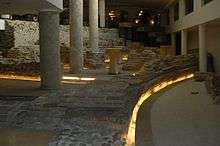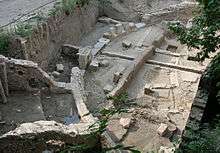Amphitheatre of Serdica
Coordinates: 42°41′50″N 23°19′42″E / 42.69722°N 23.32833°E

The Amphitheatre of Serdica (Latin: AMPHITEATRUM SERDICENSE; Bulgarian: Амфитеатър на Сердика, Amfiteatar na Serdika) was an amphitheatre in the Ancient Roman city of Ulpia Serdica, now Sofia, the capital of Bulgaria. Discovered in 2004 and the subject of excavations in 2005 and 2006, the ruins of the amphitheatre lie on two adjacent sites in the centre of modern Sofia. The amphitheatre was built in the 3rd–4th century AD on top of a 2nd–3rd century theatre which had been ravaged by the Goths. However, the amphitheatre remained in use for less than a century and was abandoned by the 5th century.
With an arena only around 10 m (33 ft) smaller than the Colosseum, the Amphitheatre of Serdica was among the biggest in the eastern part of the Roman Empire and the largest in what is today Bulgaria. It lay outside the city walls of Serdica and hosted fights between gladiators and wild beasts, which were advertised at the entrance of the city.
History
The Amphitheatre of Serdica was built on top of an earlier Roman theatre, which was constructed in the 2nd or 3rd century AD. Its ruins were discovered 5 metres (16 ft) under the amphitheatre ruins.[1][2] The theatre, 55 m (180 ft) wide, was perhaps built simultaneously with Serdica's defensive walls under Commodus (r. 177–192). It was active during the reigns of Septimius Severus (r. 193–211) and Caracalla (r. 198–217); the former may have visited the theatre with his family in 202 or 209. In the first half of 268, however, a Gothic raid ravaged and burned the theatre, forcing its permanent abandonment.[2]
As evidenced by coin and ceramic findings, including a rare bronze medallion of Antinous, the amphitheatre was constructed on top of the theatre ruins in two stages during the late 3rd and early 4th century AD, under Roman emperors Diocletian (r. 284–305) and Constantine the Great (r. 306–337).[1][3] The amphitheatre itself was in use for less than a century, as it was abandoned by the 5th century, perhaps due to the anti-pagan policies of Theodosius I (r. 379–395). In the 5th and 6th century, barbarian invaders set up their homes within the former arena, and during the Ottoman period (late 14th–19th century) it was used as a source of building materials for new housing.[2]
Discovery

The existence of a Roman amphitheatre in ancient Serdica had been conjectured ever since 1919, when a stone plate depicting an amphitheatre's facade and fights between gladiators and wild animals was unearthed near what is today the Council of Ministers of Bulgaria edifice. The plate shows crocodiles, bears, bulls and wild cats as involved in the fights. It is thought to have stood at the entrance of Roman Serdica, so as to serve as advertisement for these events. The plate is currently displayed in the National Archaeological Institute with Museum of Bulgaria in the same city.[1]
The amphitheatre itself was accidentally discovered in 2004, during the early constructions of what came to be known as the Arena di Serdica Hotel.[1][4] In the modern cityscape of Sofia, the ruins lie south of Knyaz Aleksandar Dondukov Boulevard, between the Goethe-Institut headquarters and the embassy of the United Kingdom. Until the digging of the foundations of a National Electric Company office building in the vicinity in July 2006[5] came across further ruins, however, it was not clear that the unearthed Roman structure was indeed part of a large arena. The east gate and the section of the amphitheatre within the hotel lot, which is about 1/6th of the entire building, was preserved and incorporated into the hotel's ground floor. It is freely accessible for tourists during the day, except on Mondays,[1] and includes a small expositions of coins and ceramics unearthed on the site.[4] As of 2007, the west gate and the adjacent part of the amphitheatre was being excavated at the National Electric Company lot and a campaign had begun to prevent the construction of the planned building on the site.[2]
Physical description
With its original dimensions of 60.5 m × 43 m (198 ft × 141 ft), the arena of the Amphitheatre of Serdica is commonly cited as having been some 10 m (33 ft) smaller than the Colosseum in the imperial capital Rome.[2][5] It ranked among the largest in the eastern part of the empire and was much larger than two other Roman amphitheatres in modern Bulgaria, at Diocletianopolis (Hisarya) and Marcianopolis (Devnya). In terms of architecture, the amphitheatre is comparable to the Arènes de Lutèce in modern Paris, France, and was designed for a maximum attendance of more than 20,000[2] or around 25,000.[1] Like arenas in the Mediterranean region, the Amphitheatre of Serdica has an east–west orientation.[2] It lay outside the city walls of Serdica.[4]
The stand for high-ranking Roman officials lay in the southern section of the amphitheatre, near what is today the National Art Gallery. The amphitheatre featured two main gates, from the west and the east, linked by an underground water canal. The west gate, which reaches 3.5 m (11 ft) in width, is estimated to have been topped by an arch 5 m (16 ft) high. Among the excavated and preserved ruins are the main entrance, the underground level, part of the main section with at least seven spectator seats and gates with sliding doors to let animals into the arena. The opus mixtum construction technique was employed in the construction of at least a part of the amphitheatre. Items discovered during the amphitheatre excavations include bear and boar bones, hundreds of bronze coins[2] and clay stones imprinted with the footprints of goats, dogs and cats.[1]
See also
References
- 1 2 3 4 5 6 7 "The amphiteater of ancient Serdica (Amphiteatrum Serdicense)". Arena di Serdica Residence Hotel Sofia. Archived from the original on 18 May 2011. Retrieved 17 May 2011.
- 1 2 3 4 5 6 7 8 Paunov, Evgeni (May–June 2007). "Roman entertainment in Sofia-Serdica". Minerva: The International Review of Ancient Art & Archaeology. London: Aurora Publications. 19: 40–41. ISSN 0957-7718.
- ↑ Paunov, Evgeni (2010). "Антиной в Сердика: рядък медальон на фаворита на Хадриан от Софийския амфитеатър" [Antinoüs in Serdica: A rare medallion of Hadrian's favourite from the Sofia Amphitheatre]. БУДИТЕЛ" / BUDITEL (in Bulgarian). Sofia. 1 (15): 42–48. ISSN 1312-7829.
- 1 2 3 Bulgarie. Guide de tourisme (in French). Michelin. 2009. p. 113. ISBN 978-2-06-713911-4.
- 1 2 Kay, Annie (2008). Bulgaria: The Bradt Travel Guide. Bradt Travel Guides. pp. 89–90. ISBN 978-1-84162-155-5.
External links
| Wikimedia Commons has media related to Sofia amphitheatre. |